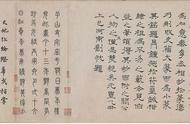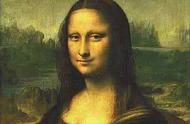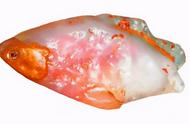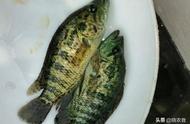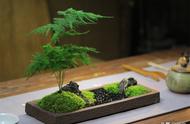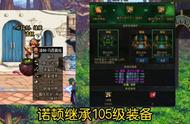Five Oxen, a painting by renowned Tang Dynasty artist Han Huang (723–787), is housed in the Palace Museum in Beijing.
《五牛图》为唐代著名画家韩滉(723―787)所作,藏于北京故宫博物院。
Han Huang was born in Chang’an during the reign of Emperor Xuanzong (685–762), and served as a chancellor during the reign of Emperor Dezong (742–805).韩滉生于唐玄宗(685—762)开元年间,长安人,唐德宗(742—805)年间任宰相。
Han was renowned for painting people and animals with detailed facial expressions. He was especially distinguished at painting agricultural life and livestock, including oxen and goats.韩滉以人物、畜兽画著称,神态刻画细致入微,对田家风俗和牛羊等家畜的描摹尤其出色。
Five Oxenis 139.8 centimeters long and 20.8 centimeters wide. The painting, as the name suggests, is of five oxen without any background. The oxen are positioned in a line, each with distinctive appearance, walking or standing, holding their heads high or low. The oxen have bright, piercing eyes and different temperaments: lively, docile, romping and even eccentric.
《五牛图》纵20.8 厘米,横139.8 厘米。顾名思义,画的是五头牛,画面上没有背景衬托。五头牛一字排开,各具状貌,姿态互异:或行,或立,或俯首,或昂头。五牛瞳眸炯炯有神,性情各不相同:活泼、温顺、喧闹甚或乖僻。
The Night Revels of Han Xizai
《韩熙载夜宴图》

The Night Revels of Han Xizaiby Southern Tang (937–975) artist Gu Hongzhong reproduces the historical scene of Southern Tang Minister Han Xizai’s evening banquet. It shows the host and guests, singing and dancing, laughter and joy, as well as the protagonist’s detachment and a sense of gloom. The surviving copy is a 28.7 cm × 335.5 cm, ink and color on silk handscroll made during the Song Dynasty, and is now housed in the Palace Museum in Beijing.
《韩熙载夜宴图》为南唐(937—975)画家顾闳中所作,再现了南唐大臣韩熙载夜宴宾客的历史场景,描绘了宴会上主客揉杂、弹丝吹竹、清歌艳舞、调笑欢乐的场面,又刻画了主人公超脱不羁、沉郁寡欢的性格。现存宋摹本手卷,绢本设色,纵28.7 厘米,横335.5 厘米,现藏于北京故宫博物院。
Han Xizai (902–970) was a scholar-official of the Southern Tang court. As he wanted to save himself from a delicate political situation, Han pretended to live a dissolute life, so as to dispel Emperor Li Yu’s (937–978) doubts and suspicion.韩熙载(902—970), 南唐文臣。他为了从复杂的政治局势中脱身,消除后主李煜(937—978)对自己的猜忌,假装过着放荡的生活。
Gu Hongzhong (910–980) was a court-painter in the painting academy of the Southern Tang Dynasty during the Five Dynasty and Ten Kingdoms period (907–979). Emperor Li Yu sent Gu to spy on one of Han’s sumptuous parties, leading Gu to produce this famous artwork.顾闳中(910—980), 五代十国(907—979)南唐画家,任南唐画院宫廷画师。后主李煜派其潜入韩府偷看韩熙载夜宴的奢华场面。顾闳中因此绘制出这幅名画。
This narrative painting is split into five distinct sections: Han Xizai listens to the pipa, watches dancers, takes a rest, plays string instruments, and then sees guests off. It shows precise portraits of more than 40 figures with fine and continuous brush lines and delicate colors.该叙事画卷分为五段场景,即听乐、观舞、暂歇、清吹、散宴。作品描绘了40 多个人物,造型准确精微,线条工细流畅,色彩绚丽清雅。
The work was not only a painting about personal life, but also represented many features from that period.这幅画不仅展现了韩熙载的个人生活,也反映了那个时代的多种风情。
A Thousand Li of Rivers and Mountains
《千里江山图》

Wang Ximeng, a teenage artist during the Song Dynasty of China, painted A Thousand Li of Rivers and Mountainsin 1113. Wang studied landscape painting at the Imperial Painting Academy, and was taught personally by Emperor Huizong of Song. He was only 18 years old when he painted this artwork, and he passed away probably around the age of 20.
北宋政和三年(1113 年),少年画家王希孟绘制了《千里江山图》。王希孟曾入画学为生徒,工山水,得宋徽宗亲授。他创作此画时年仅18 岁,20岁左右去世。
The background of the scene is largely colored gold—the color symbolizing wealth and royalty—further glorifying the country.这幅画的背景主要是金色,象征财富和皇权,彰显了国家的荣耀。
The hand scroll is 1,191.5 cm long and 51.5 cm wide. It depicts spectacular landscapes, excellent architecture, exotic animals, and humans living in harmony and peace. It is now part of the collection of the Palace Museum in Beijing.画卷纵51.5 厘米,横1191.5 厘米,展现了秀美山川、非凡建筑、珍禽异兽、安居百姓。现藏于北京故宫博物院。
Along the River During the Qingming Festival
《清明上河图》

Along the River During the Qingming Festivalwas painted by Zhang Zeduan (1085–1145), a court artist of the North Song Dynasty (960–1127). The handscroll captures the rich scenery and natural landscapes along the shores of Bian River in the Northern Song capital Bianliang, which was located near modern-day Kaifeng in Henan Province.
《清明上河图》, 北宋(960—1127)宫廷画师张择端(1085—1145)所作。该手卷反映了北宋都城东京汴梁(今河南开封附近)汴河两岸的街市繁荣景象和自然风光。
Painted in light colors on silk and measuring 24.8cm × 528.7cm, the original work is now in the collection of the Palace Museum in Beijing.原画纵24.8 厘米, 横528.7 厘米,绢本浅色。现藏北京故宫博物院。
Dwelling in the Fuchun Mountains
《富春山居图》



